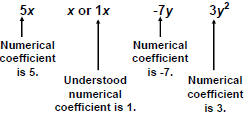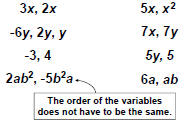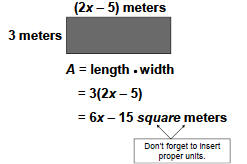Solving Equations and Problems Solving
| Section 3.1
Simplifying Algebraic
|
||||||||||||||
| In algebra letters called variables represent numbers.
The addends of an algebraic expression are
|
||||||||||||||
| A term that is only a number is called a
constant term, or simply a constant. A term that contains a variable is called a variable term.
|
||||||||||||||
| The number factor of a variable term is called
the numerical coefficient . A numerical coefficient of 1 is usually not written.
|
||||||||||||||
| Terms that are exactly the same, except that
they may have different numerical coefficients are called like terms .
|
||||||||||||||
| A sum or difference of like terms can be simplified using the distributive property.
Distributive Property |
||||||||||||||
|
By the distributive property, |
||||||||||||||
| The commutative and associative properties of addition and multiplication help simplify expressions.
Properties of Addition and Multiplication |
||||||||||||||
| The grouping of numbers in addition or multiplication can be changed without changing their sum or product.
Associative Property of Addition |
||||||||||||||

Examples of Commutative and Associative Properties
|
||||||||||||||
| We can also use the distributive property to multiply expressions.
The distributive property says that |
||||||||||||||
| To simply expressions, use the distributive property first to multiply and then combine any like terms.
Simplify: 3(5 + x) - 17
|
||||||||||||||
| Finding Perimeter
Perimeter is the distance around the figure.
|
||||||||||||||
| Finding Area
|
||||||||||||||
 Don’t forget . . .
Perimeter: |
||||||||||||||
| Prev | Next |








